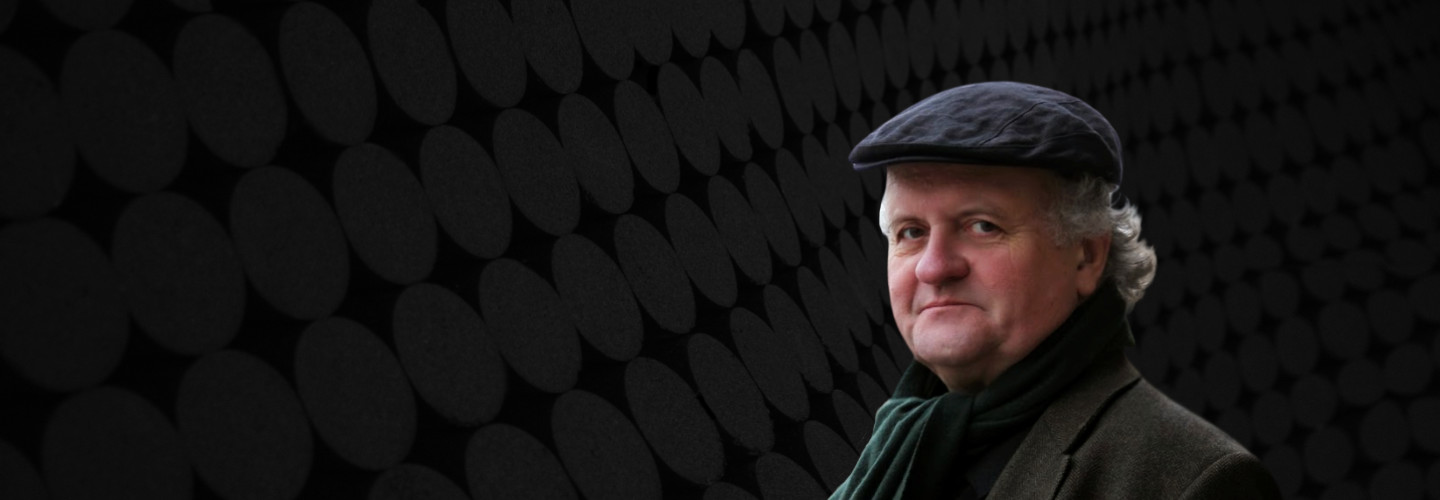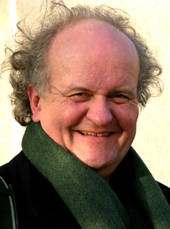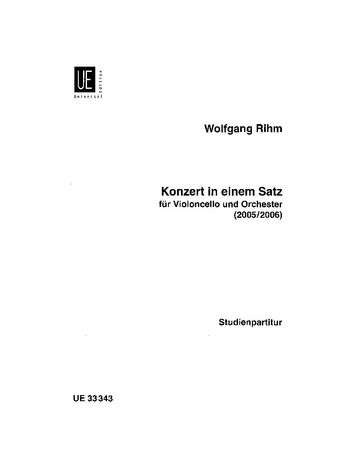

Wolfgang Rihm
Konzert in einem Satz
Short instrumentation: 2 2 2 2 - 2 1 1 0 - perc, hp, str(14 12 10 8 6)
Duration: 25'
Dedication: Dedicated to Steven Isserlis
Instrumentation details:
1st flute (+picc)
2nd flute (+picc)
oboe
cor anglais
1st clarinet in A
2nd clarinet in A
bassoon
contrabassoon
1st horn in F
2nd horn in F
trumpet in C
trombone
percussion
harp
violin I
violin II
viola
violoncello
contrabass
Rihm - Konzert in einem Satz for violoncello and orchestra
Printed/Digital
Translation, reprints and more

Wolfgang Rihm
Rihm: Konzert in einem Satz für Violoncello und OrchesterOrchestration: für Violoncello und Orchester
Type: Solostimme(n)

Wolfgang Rihm
Rihm: Konzert in einem Satz für Violoncello und OrchesterOrchestration: für Violoncello und Orchester
Type: Studienpartitur (Sonderanfertigung)
Sample pages
Audio preview
Work introduction
Singing in the Extreme
Song is unquestionably central to all music. However various its manifestations may be, it is still the key concept even for such a piece as Rihm’s new cello concerto, as the score indicates; its general designation is Allegro moderato e cantabile, the agogic is cantando (= “singing”) when the solo instrument enters and the Arioso after the first solo cadenza, and the end of the piece is marked più tranquillo (molto cantabile). These performance indications are within music which is freely flowing, its formal development quite predominantly induced and determined by the solo cello. The soloist (in this case Steven Isserlis, the concerto’s dedicatee) scarcely pauses, spinning out his line virtually without interruption, leaving the impression of a great song, nestled as it were in the orchestra.
The way in which the cello enters amid a gently sparkling basic sound of oscillating figures in the high strings as it begins an unadorned melody can be described as songlike, its beginning perhaps distantly reminiscent of Schubert (e.g. the opening of the “Unfinished” symphony where, also marked Allegro moderato, the oboes raise a comparably clear melody above over typical accompanying figures in the strings). At all events, the relation between accompaniment and instrumental song has never been so distinctly pronounced in Rihm’s concert compositions as in the first bars of this concerto. Even the harp – which, in other orchestral works, Rihm often uses as a type of interference factor – supports the uniform, virtually idyllic effect of the sonic image. The beginning loses its clarity when the winds enter but, at least in the first third of the work, this “primal condition” penetrates again and again through the orchestral agglomerations as they become ever more dense and excited.
Cantabile proliferations and vox humana
By now, dealing with the differing forms and notions of song (even in purely instrumental music) has become one of the main branches of Rihm’s protean oeuvre, as eloquently evidenced by such titles of concertos and orchestral works such as gesungene Zeit [“Sung Time”] for violin and orchestra, Doppelgesang for clarinet, violoncello and orchestra and Ernster Gesang for orchestra. In this regard, Rihm is primarily concerned with the intensity and immediacy of human singing, which he carries over into the instrumental sphere, impelling it into regions of expression impossible for the human voice for purely technical reasons. In each case, a notion of song is centrally determined by the concept, in order to express rich internal events. He is never concerned with mere “bel canto” in the unreflecting sense of that term; the cantabile often intersperses the music in plant-like proliferations, almost always succeeding in asserting itself in the foreground of the musical occurrences.
As Rihm understands it, song is inseparable from the sound of the instrument producing it. Thus he naturally tends toward concertante solo-tutti scoring, i.e. soloist plus orchestra, as in the Concerto in One Movement, wherein the cello’s characteristically broad sonic spectrum comes to the fore, particularly due to its extremely wide range. Although its deepest registers are also fully exploited, the soloist plays mostly on the A string, with its especially melodically carrying quality, making his way well into the cello’s topmost range (which is high even for a violin) and veritably wresting the notes from the instrument. The piece has long passages which could seem to be part of a violin concerto, if the cello were not baring an intensity scarcely achievable by other string instruments (due to its large sounding box and, not least, the technical difficulties involved in playing the music). These extreme ranges give the cello an especially intense vox humana which make it sing in an extraordinary way.
Reflection on the concerto form
Rihm confronts the cello concerto genre for the third time now with his Concerto in One Movement, after Monodram. Musik für Violoncello und Orchester (1983) and Styx und Lethe. Musik für Violoncello und Orchester (1998). In Monodram, the dark colours of the orchestra’s low registers were in the foreground; the solo cello could only assert itself against that raw power with the greatest effort. Blocky, contiguously juxtaposed expressive regions between dolorous, grave sonorities and overwrought ostinato figures necessitated a manner of composing allowing disparate factors to collide within a confined space.
For Styx und Lethe. Musik für Violoncello und Orchester Rihm composed a spirited, dynamic solo part for the cello, its stupendous virtuosity accompanied by the rather chordally structured and withal clearly graduated orchestra. The differing speeds of the currents of the two underworld rivers Styx (across which Charon the ferryman transports souls of the dead to Hades) and Lethe (from which the souls of the dead drink to forget the experiences of their terrestrial lives) might have been a starting point for the piece, even if they did take on forms in the course of working on it which became very different from those suggested by the title from the initial phase of the compositional process.
Rihm dispensed entirely with a metaphoric title for the Concerto in One Movement; at that, it is his first to be subtitled simply “music for violoncello and orchestra” and which, moreover, has deliberate recourse to the centuries-old concept of the concerto, or the basic concertante form in which here the cello liaises between contrasting parts. With Rihm, the result is the endeavour to find optimal perceptibility for the piece – for the solo part (which is often the highest voice above the orchestra) and for the mostly unostentatious instrumentation. Two long cadenzas and many colla parte passages (with the sparingly-scored orchestra accompanying) add to the impression of concertante playing in the classical sense, complete with rests for the cello while the orchestra – now more boisterous – executes intermezzi. Consequently, the piece emerges as the one of Rihm’s most comparable to a traditional cello concerto, in terms of both its title and its entire conceptual make-up.
© Gerald Resch
Use and reproduction of this text only with the author’s express permission. (Gerald Resch is a freelance author, composer and musicologist who teaches musical analysis at Bruckner University in Linz).
Translated by Grant Chorley
